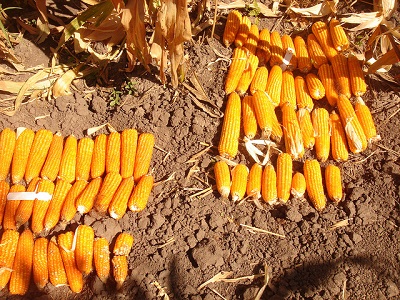
A new study from the International Maize and Wheat Improvement Center (CIMMYT) and Wageningen University examines the preferences and needs of maize processors and consumers in Sub-Saharan Africa (SSA). According to the authors, the demand for maize, a staple crop in SSA, will triple by 2050 due to rapid population growth. At the same time, the effects of climate change, such as erratic rainfall and drought, threaten agricultural productivity and the ability to meet this growing demand, while persistently high malnutrition pose additional challenges to the region. The authors suggest six objectives to enhance maize breeding programs for better food security and nutrition in SSA.
First, they recommend breeding programs enhance the nutrient density of maize through biofortification to help reduce deficiencies in vitamin A, zinc and protein. Since wheat is difficult to grow in most of SSA and expensive to import, they also suggest that programs breed to enhance the suitability of maize for making bread and snacks. The authors recommend breeding to improve maize for use as ‘green maize’ – the first crop to reach the marketplace after the dry season. If suitable green maize varieties are available, the hunger gap between seasons could be significantly reduced.
The authors’ fourth suggestion is breeding to improve characteristics that enhance the efficiency of local processing. For example, soft maize is preferred for traditional dry and wet milling, but hard maize is usually preferred for pounding or refining processes in the home. Lastly, the authors suggest breeding to reduce waste by maximizing useful product yield and minimizing nutrient losses, and breeding to reduce anti-nutrient concentrations in grains. For example, phytate or phytic acid is a naturally occurring compound found in cereals that binds with minerals and prevents their absorption. Transgenic and gene editing approaches may offer viable options for reducing phytate production.
The authors emphasize that none of these opportunities to enhance breeding strategies are “magic bullet” solutions. Sustainable, diversified crop production and post-harvest management strategies will play an important role in improving nutrition, food security and livelihoods.
Check out the full article: “Sub-Saharan African maize-based foods: Technological perspectives to increase the Food and nutrition Security impacts of maize Breeding programmes” 2018. Ekpa, O., Palacios-Rojas, N., Kruseman, G., Fogliano, V., Linnemann, A. (2018). In: Global Food Security, v. 17, pp. 48-56 and check out other recent publication by CIMMYT staff below:
- Bayesian functional regression as an alternative statistical analysis of high-throughput phenotyping data of modern agriculture. Montesinos-López, A., Montesinos-Lopez, O.A., De los Campos, G., Crossa, J., Burgueño, J., Luna-Vazquez, F.J. In: Plant Methods v. 14, art. 46.
- Exploring the physiological information of sun-induced chlorophyll fluorescence through radiative transfer model inversion. Celesti, M., van der Tol, C., Cogliati, S., Panigada, C., Peiqi Yang, Pinto Espinosa, F., Rascher | Miglietta, F., Colombo, R., Rossini, M. In: Remote Sensing of Environment v. 215, p. 97-108.
- Genome-wide association mapping for resistance to leaf rust, stripe rust and tan spot in wheat reveals potential candidate genes. Juliana, P., Singh, R.P., Singh, P.K., Poland, J.A., Bergstrom, G.C., Huerta-Espino, J., Bhavani, S., Crossa, J., Sorrells, M.E. In: Theoretical and Applied Genetics v. 131, no. 7, p. 1405-1422.
- High-throughput method for ear phenotyping and kernel weight estimation in maize using ear digital imaging. Makanza, R., Zaman-Allah, M., Cairns, J.E., Eyre, J., Burgueño, J., Pacheco Gil, R. A., Diepenbrock, C., Magorokosho, C., Amsal Tesfaye Tarekegne, Olsen, M., Prasanna, B.M. In: Plant Methods v. 14, art. 49.
- IPM to control soil-borne pests on wheat and sustainable food production. Dababat, A.A., Erginbas-Orakci, G., Toumi, F., Braun, H.J., Morgounov, A.I., Sikora, R.A. In: Arab Journal of Plant Protection v. 36, no. 1, p. 37-44.
- Long-term impact of conservation agriculture and diversified maize rotations on carbon pools and stocks, mineral nitrogen fractions and nitrous oxide fluxes in inceptisol of India. Parihar, C.M., Parihar M.D., Sapkota, T.B., Nanwal, R.K., Singh, A.K., Jat, S.L., Nayak, H.S., Mahala, D.M., Singh, L.K., Kakraliya, S.K., Stirling, C., Jat, M.L. In: Science of the Total Environment v. 640-641, p. 1382-1392.
- Major biotic maize production stresses in Ethiopia and their management through host resistance. Keno, T., Azmach, G., Dagne Wegary Gissa, Regasa, M.W., Tadesse, B., Wolde, L., Deressa, T., Abebe, B., Chibsa, T., Mahabaleswara, S. In: African Journal of Agricultural Research v. 13, no. 21, p. 1042-1052.
- Natural variation in elicitation of defense-signaling associates to field resistance against the spot blotch disease in bread wheat (Triticum aestivum L.). Sharma, S., Ranabir Sahu, Sudhir Navathe, Vinod Kumar Mishra, Chand, R., Singh, P.K., Joshi, A.K., Pandey, S.P. In: Frontiers in Plant Science v. 9, art. 636.
- Population structure of leaf pathogens of common spring wheat in the West Asian regions of Russia and North Kazakhstan in 2017. Gultyaeva, E.I., Kovalenko, N.M., Shamanin, V.P., Tyunin, V.A., Shreyder, E.R., Shaydayuk, E.L., Morgunov, A.I. In: Vavilovskii Zhurnal Genetiki i Selektsii v. 22, no. 3, p. 363-369.
- The ADRA2A rs553668 variant is associated with type 2 diabetes and five variants were associated at nominal significance levels in a population-based case–control study from Mexico City. Totomoch-Serra, A., Muñoz, M. de L., Burgueño, J., Revilla-Monsalve, M.C., Perez-Muñoz, A., Diaz-Badillo, A. In: Gene v. 669, p. 28-34.
 Capacity development
Capacity development 
